Lehenga
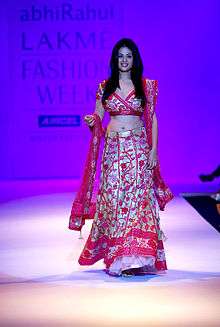
Lehenga or lehnga or langa (Hindi: लहंगा Urdu: لہنگا lahangā, Punjabi: ਲਹਿੰਗਾ lēhēṅgā, Gujarati: લેહગા lēhagā, Bengali: লেহেঙ্গা lehengā, Telugu: లంగా Kannada: ಲಂಗ laṅgā), Ghagra or gagra (Hindi: घाघरा Gujarati: ઘાઘરા Urdu: گھاگھرا ghāghrā, Punjabi: ਘਾਗਰਾ ghāgrā), also Chaniya (Gujarati: ચણિયા) Pavadai (Tamil: பாவாடை) and Lacha (Malayalam: ലഹങ്ക)[1] is a form of full ankle-length skirt worn by women[2] from the Indian subcontinent which is long, embroidered and pleated. It is worn as the bottom portion of a Gagra choli or Langa Voni. It is secured at the waist and leaves the lower back and midriff bare.[3] In the Indian subcontinent, various types of traditional embroidery work are done on lehenga, with Gota patti embroidery being one of popular types for the festivals and weddings.
History
The origin of modern Lehenga can be traced back to mughal era. It was in the beginning worn simply by women in Mughal era.[4] During the 10th century, Lehenga choli became popular as an attire amongst women mainly in North India.[5] It evolved through fine craftsmanship with the arrival of Mughals in India and their subsequent rule from the 16th to the 18th century.
Variations
The Ghagri was a narrow skirt six feet long the same length as original antariya. This style can still be seen worn by Jain nuns in India.
A-Line
A-Line lehenga has A-line hem. As per name its suggests resembling letter 'A', which is tighter on the waist and flares out at the bottom. This is a very versatile type of lehenga as suitable for hourglass and pear-shaped body types.
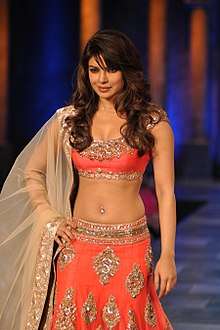 Priyanka Chopra in A-Line lehenga on a fashion show
Priyanka Chopra in A-Line lehenga on a fashion show Shamita Shetty in A-Line lehenga on a fashion show
Shamita Shetty in A-Line lehenga on a fashion show.jpg) Lilavati shave A-Line lehenga at Manish Malhotra's fashion walk
Lilavati shave A-Line lehenga at Manish Malhotra's fashion walk
Flared
Flared aka Circular is kind of lehenga has several of volume and pleats. This style most suitable for all body types but mainly recommended for round and rectangular shape.
 Yuvika Chaudhary in a flared lehenga
Yuvika Chaudhary in a flared lehenga
Double flared
Double flared lehenga has double sometimes triple or as much flare you want to use, which increase the volume of lehenga.
 Double flared lehenga
Double flared lehenga Double flared Ghagra Choli
Double flared Ghagra Choli
Mermaid
Mermaid aka Fishtail, Trumpet lehenga looks like fishtail; with tight till knees then flared from calves. This kind of design type usually suitable for hourglass and Pear-shaped body shape.
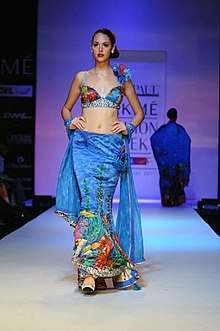 Fish cut Lehenga
Fish cut Lehenga
Panelled
Panelled lehenga has several horizontal panels of fabrics attached altogether create the flare of the lehenga. The volume of the flare is increased for too many panels. These panels can be same or different depending upon one’s choice, which are suitable for Inverted and rectangular body shapes.
 Embroidery panelled lehenga
Embroidery panelled lehenga Anjali Lavania in panelled lehenga
Anjali Lavania in panelled lehenga Shraddha Kapoor in panelled lehenga
Shraddha Kapoor in panelled lehenga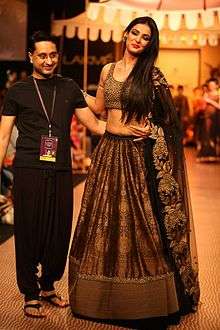 Shantanu Goenka in panelled lehenga at Lakme Fashion Week
Shantanu Goenka in panelled lehenga at Lakme Fashion Week.jpg)
Sharara
Sharara aka Pavadai, Langa Davani, Langa Voni, and sometimes Half Saree; is a kind of lehenga will have two big palazzos or pants in the bottom. Traditionally in Andhra Pradesh and Karnataka, it is also known as Langa and part of another traditional dress Langa voni. This is typically worn in South India with dupatta wrapped around the waist and draped on the shoulder like saree.
 Ankita Shorey in half saree lehenga
Ankita Shorey in half saree lehenga
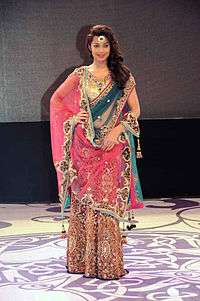
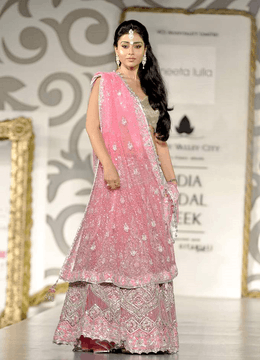 Shriya Saran in half saree lehenga
Shriya Saran in half saree lehenga
Straight
This kind of lehenga have straight silhouette without any space for its pleats or gathers for fullness. Instead, side slit is provided for easy movement; even suitable for occasional wear and most appropriate for the inverted triangle or rectangular T body shapes.
Trail
Trail lehenga using extra fabric making a trail at behind.
Gallery
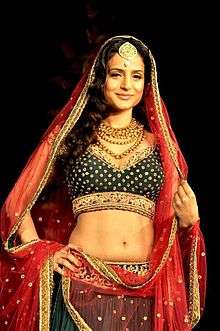 Patel in a fashion show with lehenga
Patel in a fashion show with lehenga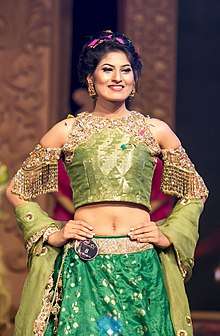 Avril, Miss Bangladesh 2017, wearing designer lehenga in a fashion walk.
Avril, Miss Bangladesh 2017, wearing designer lehenga in a fashion walk..jpg) Galrani at IIFA Utsavam Awards 2016
Galrani at IIFA Utsavam Awards 2016.jpg) Kiara Advani in a fashion show
Kiara Advani in a fashion show
References
| Wikimedia Commons has media related to Lehenga. |
- ↑ Fashions from India - Tom Tierney
- ↑ "lehnga". OxfordDictionaries.com. Oxford University Press. 2018. Retrieved 2018-06-26.
- ↑ Social Science a Textbook in History for Class IX as per New Syllabus - FK Publications
- ↑ UberTailor (2015-11-17). "The Interesting History of Lehenga Choli". UberTailor. Retrieved 2018-10-06.
- ↑ "The Indian Lehenga Choli". Utsavpedia. Retrieved 2018-06-24.